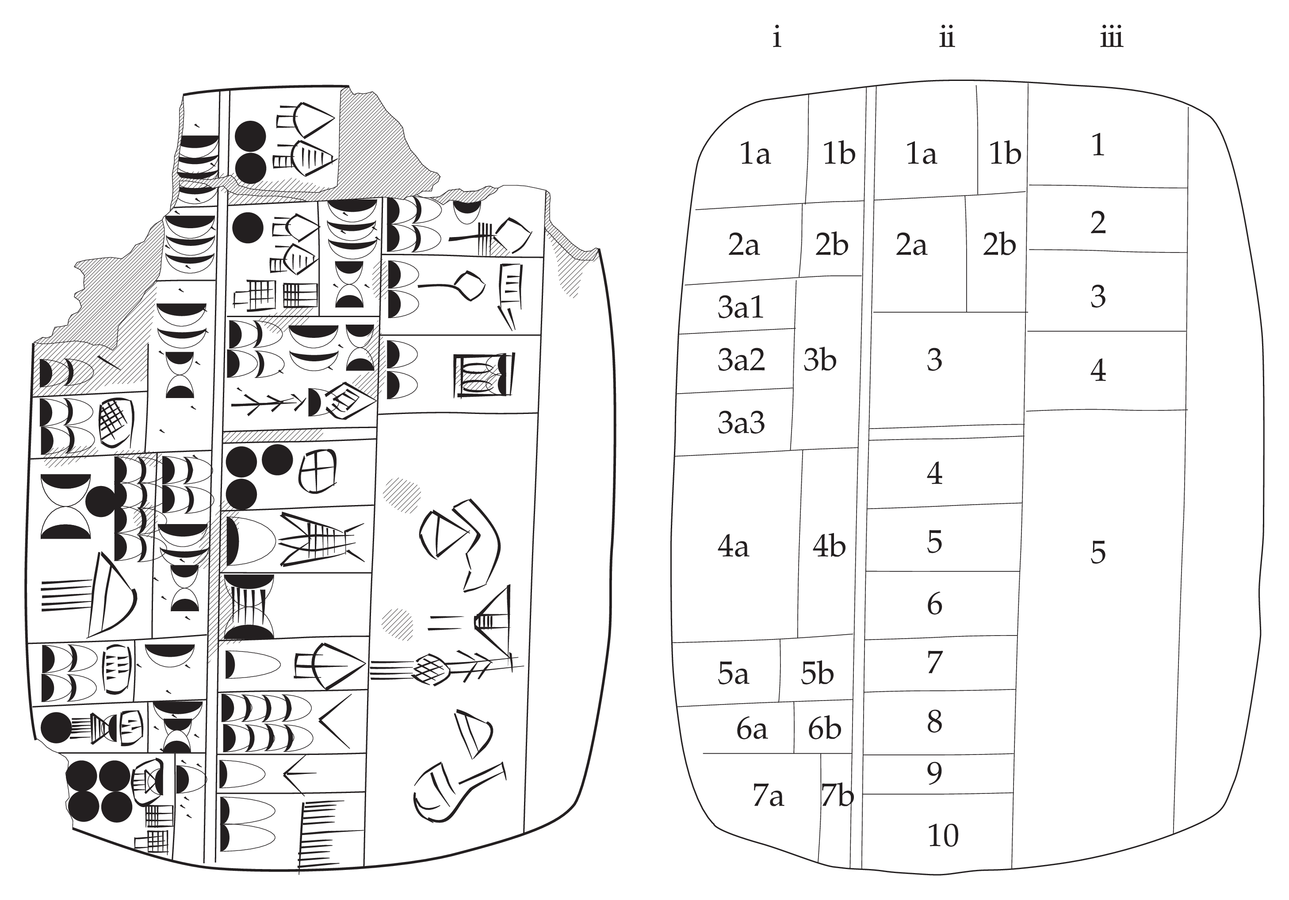Introduction
Undoubtedly one of the most important achievements in Peter Damerow’s distinguished career, first at the Max Planck Institute for Human Development and Education and later at the Max Planck Institute for the History of Science (MPIWG), was the systematization of the Late Uruk metrologies in collaboration with Bob Englund and Hans Nissen in the 1980s.1 This was part of a broader effort to locate the key moments in the earliest history of human thought and investigate those social contexts and institutional locales in which human awareness and reflection rose to new heights.2 In memory of Peter Damerow, I would like to offer a small contribution to the further decipherment of Late Uruk metrology, namely the terminology and enumeration used in the butchering of sheep in the earliest cuneiform documents as well as the distribution of these portions of meat in so-called diacritical feasts.3 These meat distributions were central to the long history of Mesopotamian institutions, but more importantly the textual materials that defined the offices and professions that were eligible for these distributions (and also audited the distributions themselves) represent one of the earliest examples of second-order categorization and notation in human history.
As Damerow recognized years ago, Near Eastern feasting is one of the privileged contexts, if not the privileged context, for understanding the social forces driving the earliest advances in the history of writing and numeracy. Thus, it is no accident that in the very same volume in which Michael Dietler first coined the concept of a diacritical feast, viz. Food and the Status Quest (Wiessner and Schiefenhövel 1996), Damerow contributed a paper entitled “Food production and social status as documented in proto-cuneiform texts” (Damerow 1996) that sought to establish a link between the well-known professions list and the distribution of beer, a theme to which he would return in one of his last papers as well (Damerow 2012). In the years since Damerow’s paper, Englund has published definitive papers on proto-cuneiform grain metrology (Englund 2001) and Susan Pollock has now laid the groundwork for a general model of Near Eastern feasting and commensal politics (Pollock 2003, 2013a, 2013b), but the decisive moment of institutional self-awareness that led to the development of second- and higher-order notations has not been a central topic of investigation in recent work. If we can reduce Mesopotamian institutional life to a slogan, and in the process advance an aphorism that summarizes the intent of this paper: beer codes solidarity, but meat codes hierarchy. In other words, if we want to get to the bottom of the articulation of Mesopotamian elites, we have to look at the distribution of meat and in particular at how meat distribution was documented in the textual record.
Deciphering the Late Uruk Butchering Texts
The decisive question, if we are to make sense of meat distributions in the Late Uruk period (ca. 3300–3000 BCE), is how the individual units or portions were defined.4 Since only some individuals within the major institutions received meat rations (and multiple portions were closely linked to the highest levels within these hierarchies), the identification of this metric and its metrology within the Late Uruk documentation is of central importance to the question of Late Uruk diacritical feasting. Although there is significant lexical evidence that ŠITAa1 represented a single portion of meat or fish (see Johnson 2014), the clearest textual evidence for this comes from a group of seven or eight Late Uruk tablets in which a quantity of sheep is enumerated in the first line and the remainder of the tablet then lists cuts of meat and other animal products that derive from these sheep.5 The generic structure of these documents may be seen in a text like W 16731 (= ATU 6, pl. 85), in which six sheep yield 120 cuts of meat (ŠITAa1), or 20 portions of meat per sheep (see table 7.1).
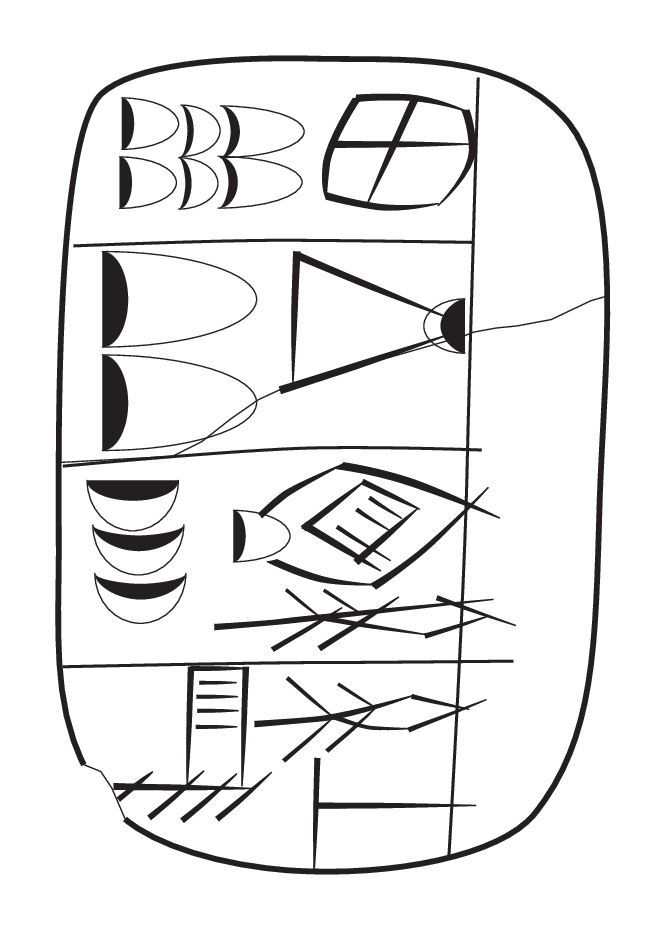 |
||
| W 16731 (= ATU 6, pl. 85, copy R. K. Englund) | ||
| (transliteration) | (translation) | |
| 1. 6(N1) UDUa | Six sheep: | |
| 2. 2(N34) ŠITAa1 | 120 portions of meat, | |
| 3. 3(N39a) ZATU714HIgunua MU | three bowls of soup. | |
| 4. ENDIB | The endib-official (is responsible). | |
Tab. 7.1: W 16731 (= ATU 6, pl. 85 [P002611], copy R. K. Englund).
Tab. 7.1: W 16731 (= ATU 6, pl. 85 [P002611], copy R. K. Englund).
Many of these texts include GEŠTUb (rather than ENDIB) in their colophon and enumerate a number of other products whose designations are related to ŠITAa1 in one way or another, such as ŠITAb1, BA.1(N57).ŠITAa1, and ŠAHIgunua. A nice example of the fuller version of this type of document is W 6066,a (= ATU 5, pl. 3; see table 7.2). Although many of the items in this document cannot be identified, the five commodities that are designated with a sign that is related to ŠITAa1 (viz. ŠITAb1, BA.1(N57).ŠITAa1, ŠITAa1, ŠAHIgunub, ŠAHIgunua in lines 2–3 and 5–7 in table 7.2) amount to 400 units in the text, which yields the same ratio of 20 cuts of meat per sheep that we saw in W 16731 (see table 7.1 above). Most of the other examples of this type of document are too damaged to allow for a precise reconstruction of the numbers involved, but those parts of these other texts that do survive show roughly the same ratio.6 There are also a number of Proto-Elamite texts that exhibit a formal similarity to these butchering texts (particularly in their use of the Proto-Elamite equivalent of GEŠTUb, viz. M36, in initial position) such as MDP 17 (nos. 19, 24, 111, and 136), MDP 26 (nos. 384, 385, 386), and Revue d’Assyriologie 50, p. 202, no. 11, but these will have to be investigated elsewhere.
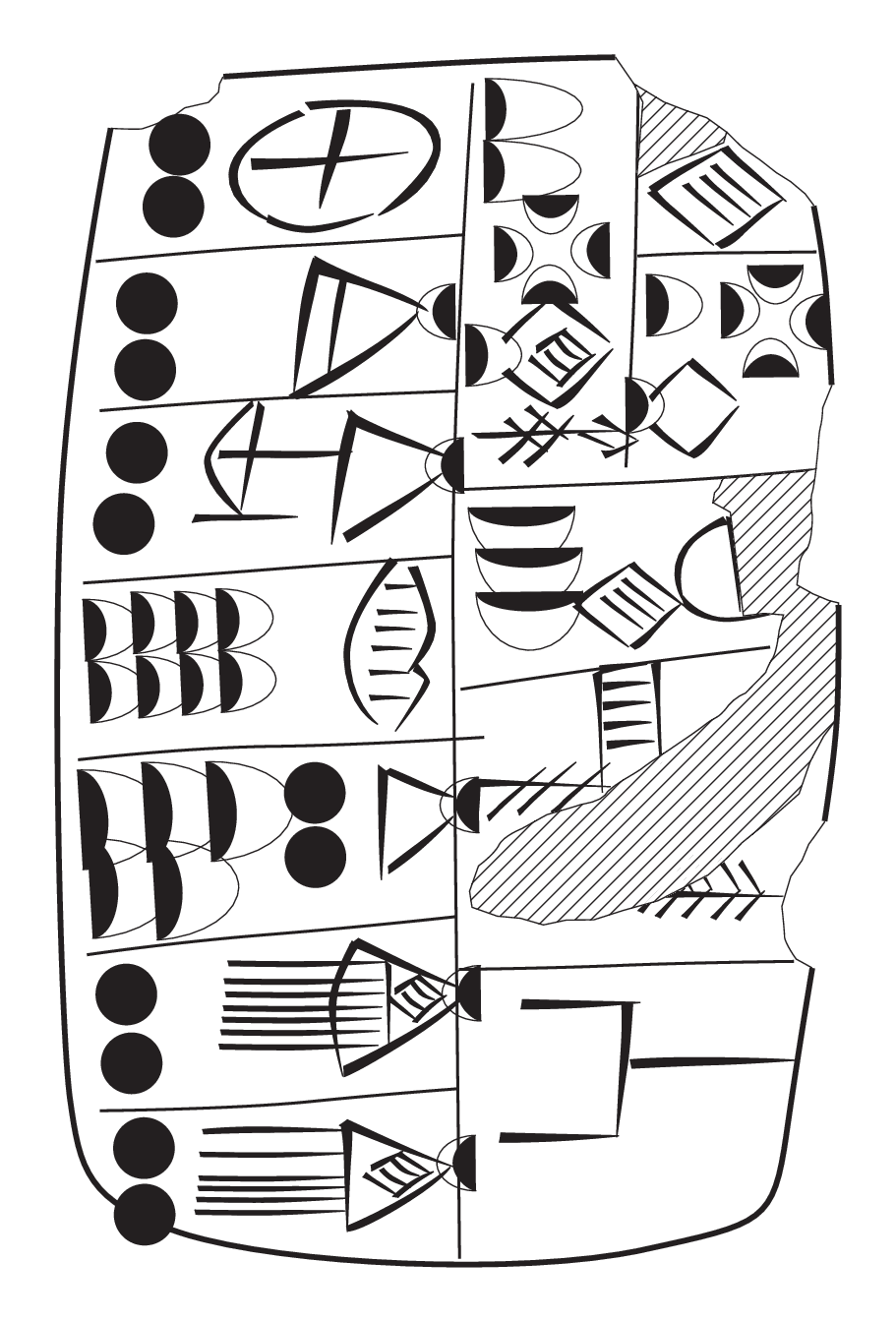 |
||
| W 6066,a (= ATU 5, pl. 3, copy R. K. Englund) | ||
| (transliteration) | (translation) | |
| obv. | ||
| i | ||
| 1. 2(N14) UDUa | 20 sheep | |
| 2. 2(N14) ŠITAb1 | 20 ... | |
| 3. 2(N14) BA 1(N57) ŠITAa1 | 20 ... | |
| 4. 8(N1) KU3a | eight units of dairy fat | |
| 5. 5(N34) 2(N14) ŠITAa1 | 320 cuts of meat | |
| 6. 2(N14) ŠAHIgunub | 20 ... | |
| 7. 2(N14) ŠAHIgunua | 20 ... | |
| ii | ||
| 1a. 2(N1) 1(N28) ZATU714HIgunua MU | ||
| 1b1. [1(N1)] HIgunua | ||
| 1b2. 1(N1) 1(N28) ZATU714 | ||
| 2. 3(N39a) HIgunua ⌜SAG?⌝ | ||
| 3. ⌜ENa ŠEa⌝ [...] | ||
| GEŠTUb | The geshtu-official (is responsible) | |
Tab. 7.2: W 16731 (= ATU 6, pl. 85 [P002611], copy R. K. Englund).
Tab. 7.2: W 16731 (= ATU 6, pl. 85 [P002611], copy R. K. Englund).
Diacritical Feasts and the Surprising Continuity of Administrative Technique
Now that Late Uruk butchering practices (and the resulting metrology for portions of meat) have been clarified somewhat, we can return to the most important texts for understanding diacritical feasting in early Mesopotamia: the bookkeeping ledgers for institutional feasts that were published in MSVO 1, in particular texts such as MSVO 1, 93 (see figure 7.1). These ledgers are heavily synthetic documents, bringing together a series of individual accounts that each dealt with a particular type of highly valued product. As R. K. Englund has made clear in his review of grain metrology research (Englund 2001), MSVO 1, 93, was divided into two major subsections by a double ruling after ii 3: the initial section (i 1–ii 3) deals with grain products (including breads, pastries, and beer), ending with meat soups or stews in ii 3, while the remainder of the text records discrete objects in the sexagesimal system, including portions of meat and fish (ii 4–5), textiles (ii 8–10), and dried fruit (iii 2–3). The metadata at the end of the text (iii 5) refers to the geographical locale in which the feast took place (NIa+RU, apparently Jemdet Nasr), gives a calendrical notation for the day on which it was held (2N57 SUa GIBIL), and states that these materials were all ‘consumed’ (GU7) on that occasion.
One of the defining features of these texts (including MSVO 1, nos. 93, 107, and 108, as well as texts from other sites such as CUSAS 1, 173) is that the number of dried fish (SUHUR) is almost always twice as large as the number of sheep and goats (UDU). Thus in MSVO 1, 93 and 103, as well as CUSAS 1, 173, there are 30 sheep and goats (UDU) and 60 dried fish (SUHUR), while in MSVO 1, 108 and 109, there are 15 sheep and goats (UDU) as opposed to 30 dried fish (SUHUR). Given the ratio of 20 portions of meat per sheep (UDU) that we described earlier, this would yield 600 pieces of mutton for the tablets that mention 30 UDU or alternatively 300 pieces for those that mention 15 UDU. Although it remains unclear whether these suspiciously round numbers are linked to a system of regular cultic offerings or to the amount required to feed the members of an institution on a particular feast day, it is surprising that we find very much the same ratio and even the same exact numbers in a couple of Ur III feast ledgers from approximately a millennium later (ca. 2100–2000 BCE). In particular, the two mortuary feasts {ki-a-nag} (CUSAS 3, 972 and 975) held for a man named Šukabta, who had married into the Ur III royal family, are remarkably similar to Late Uruk texts like MSVO 1, 93. In spite of the millennium that separates these two groups of texts, the types of food and the quantities involved are very similar. And in fact it seems that the same amounts of meat and fish are listed in each of these two sets of documents:
| MSVO 1, 93 obv ii 4–5: | 15 UDU | 30 SUHUR |
| CUSAS 3, 972 obv i 16′–17′: | 15 ki de5-gaar-ki-núm | 30 ku6 al-dar-ra |
As Englund (2001, 17, n. 34) has shown, the proto-cuneiform sign SUHUR represented ‘a fish that was split’ (prior to being salted and dried), which is precisely what {ku6 al-dar-ra} means in Classical Sumerian, so the equation between SUHUR and {ku6 al-dar-ra} makes good sense. The parallel between UDU (the standard proto-cuneiform sign for sheep and goats) and {ki de5-gaar-ki-núm} is more difficult to make sense of, primarily because neither {ki de5-ga} nor its gloss ar-ki-núm are attested as descriptions of meat or fish elsewhere in the cuneiform record.7 If, however, we emend the text ever so slightly (KI and NA differ only by a single horizontal wedge), we arrive at a well-known qualification of sheep and goats ({udu}) as well as oxen ({gu4}), namely {na de5-ga}.8
We should not fall into the trap of reading purely formal or ‘physiognomic’ interpretations (Ginzburg 1989, 43–47) back into the historical record, so it is good to keep in mind that a well-defined feasting practice (and the bookkeeping techniques associated with it) may have been retasked or even revivified at a later date for quite different purposes than the original Late Uruk practice. In other words, there is no reason to assume that the Late Uruk text MSVO 1, 93, necessarily documents a mortuary rite, or that these continuities in bookkeeping represent an unbroken millennium of historical continuity in the narrow sense of the term. Even if the specific goals or institutional contexts of this bookkeeping practice did change through time, however, the overarching continuities in bookkeeping practice must have been rooted in the intersecting chaîne opératoire of a number of different economic and social sectors, ranging from the butchering of animals to the presentation of finished entrees at the feast itself. For example, if we can assume 300 pieces of mutton (15 sheep20 pieces of meat per sheep) and a roughly equivalent number of portions from the dried fish were consumed in MSVO 1, 93, these 600 pieces agree quite well with Brunke’s suggestion that approximately 600 people would have enjoyed the feast described in CUSAS 3, 972 (Brunke 2011b, 46). Both the Late Uruk and the Ur III feast ledgers are oriented to very much the same goal: the documentation and presumably the auditing of the materials expended on a particular festive occasion. So it is not surprising that their contents and format are similar; the precise replication of the same numbers of animals, however, raises the possibility that some kind of macro-historical social or institutional continuity may lie hidden behind these purely textual similarities. Further evidence is needed, however.
Two Perspectives on Meat Distributions in the Late Uruk Documentation
Unlike feast ledgers such as MSVO 1, 93, which document how various economic sectors contributed to a single festive event, the Late Uruk accountants were also rather fond of second-order descriptions of meat distributions, what we might these days see as a kind of auditing. These auditing records focus exclusively on the distribution of portions of meat and seem to be rooted in the organization and hierarchy of individual offices within a concrete institution. For lack of a better name, we can refer to this unnamed entity as the UKKIN institution on the basis of a well-known lexical list that seems to have originated as its organizational plan. The best evidence for the historical reality of this institution is the Late Uruk text W 14804, a+ (see table 7.3), which recapitulates the major bureaus of the UKKIN institution on the reverse (a list that is nearly identical to the UKKIN list), but also gives the concrete number of staff members assigned to each of these bureaus (224 staff members, viz. EN.TUR, in total). This gives us a pretty clear picture of the scale of the UKKIN institution, at least at one point in its history.
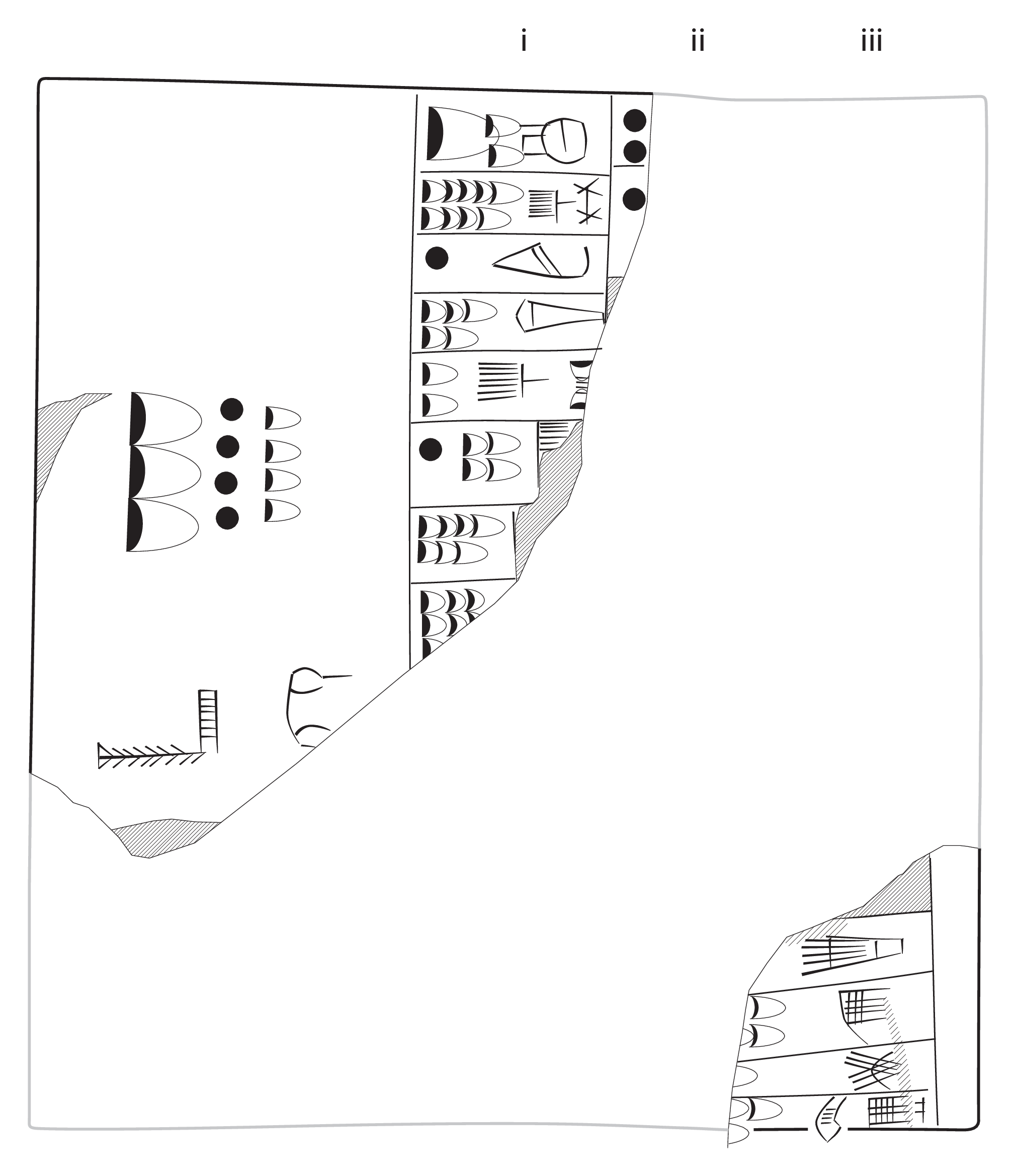 |
||
| W 14804, a+, reverse | ||
| (transliteration) | (position in UKKIN list) | |
| i | ||
| 1. 1(geš2) 2(diš) UKKIN | UKKIN 1 | |
| 2. 9(diš) GAL TE | UKKIN 2 | |
| 3. 1(u) ZATU 647 | UKKIN 4 | |
| 4. 5(diš) NIM | UKKIN 3 | |
| 5. 2(diš) GAL KISALb1 | UKKIN 5 | |
| 6. 1(u) 2(diš) ⌜ZATU753⌝ | UKKIN 8 | |
| 7. 7(diš) ⌜x⌝ [...] | ||
Tab. 7.3: W14804, a+, reverse [P002195], (columns ii and iii largely destroyed and not transliterated here).
Tab. 7.3: W14804, a+, reverse [P002195], (columns ii and iii largely destroyed and not transliterated here).
More importantly for our purposes here, however, we know of two texts, which I have elsewhere spoken of as subordinate staff lists, namely MSVO 1, 112, and IM 73409,2, which break down the distribution of meat and fish by individual office-holding recipients. Recipients who occupied particular nodes within the hierarchy of the institution received a portion of meat and were marked in these lists with the term ŠITAa1, while other recipients in other hierarchical nodes received a portion of dried fish and were marked in these lists with the term UKKINa.9 Take, for example, the following small section from MSVO 1, 112, in which a series of office-holders that are designated as ŠITAa1 are listed:
MSVO 1, 112 ii
1′.[...GALa] ŠITAa1
2′.[...] ⌜GEŠTUb⌝ ŠITAa1
3′.⌜1(N1) NUNa+ENa⌝ ŠITAa1
4′.⌜1(N1)⌝ EN AMAR ŠITAa1
5′.1(N1) NAM2.KAB ŠITAa1
6′.1(N1) AN ŠU2.EN ŠITAa1
This short extract simply represents an audit, listing a group of six office-holders who received a portion of meat on a given occasion. Thanks to a second text (W 14777,c), however, we can actually see how these six individuals were distributed within the hierarchical structure of the UKKIN institution. In table 7.4, I have lined up the foregoing entries in the extract from MSVO 1, 112, with a detailed census of a particular group of bureaus and their staff members in W 14777,c (numerals and indication of damage have been largely omitted).
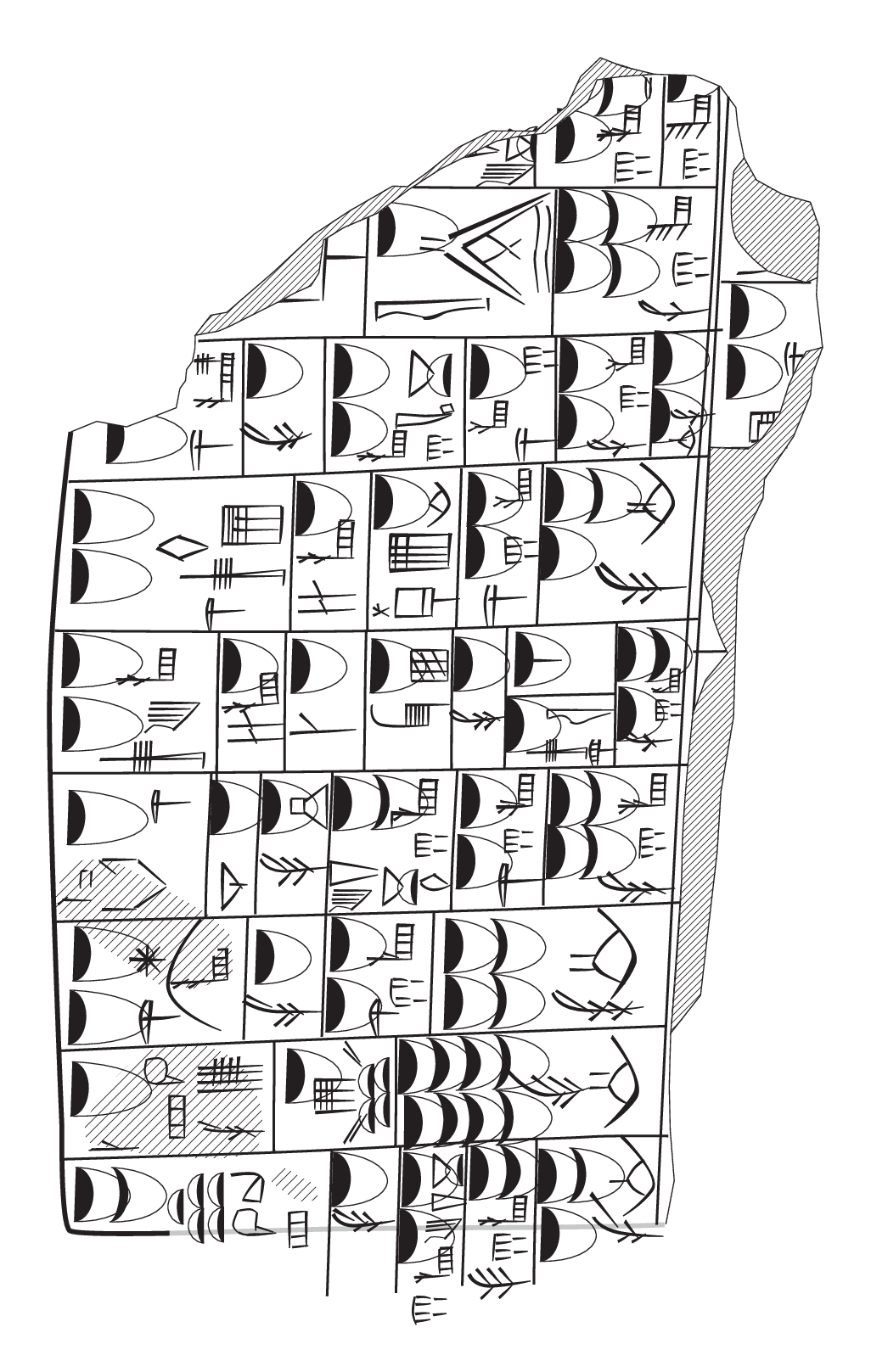 |
||
| W 14777,c i | MSVO 1, 112 ii | |
| 1′. [...] | 1′. [...GALa] ŠITAa1 | |
| 2′. [...] GEŠTUb? | 2′. [...] GEŠTUb ŠITAa1 | |
| 3′. NUNa+ENa BA / GI | 3′. NUNa+ENa⌝ ŠITAa1 | |
| 4′. ḪI E2.NUN BA | ||
| (not followed by GI) | ||
| 5′. EN ŠU NUN | ||
| 6′. EN AMAR BA / GI | 4′. EN AMAR ŠITAa1 | |
| 7′. AN ŠU2.EN BA / GI | 6′. AN ŠU2.EN ŠITAa1 | |
| PAP NAM2.KAB U2 GI | ||
| 9′. LAMa SI.MEa NAM2.KAB | 5′. NAM2.KAB ŠITAa1 |
Tab. 7.4: W 14777,c [P002179] in comparison to MSVO 1, 112 [P005179], (W 14777,c column ii not transliterated here).
Tab. 7.4: W 14777,c [P002179] in comparison to MSVO 1, 112 [P005179], (W 14777,c column ii not transliterated here).
As the parallels between BA/GI in W 14777,c and ŠITAa1 in MSVO 1, 112, suggest, bureaus in which the first subcase includes BA such as NUNa+ENa, EN.AMAR, and AN.ŠU2.EN tend to be more or less immediately followed by a subcase that includes GI (only ḪI.E2.NUN in line 4′ does not have a corresponding GI subcase), and where both a BA and a GI entry occur in a given line, we find a corresponding entry for the same bureau in the secondary staff list MSVO 1, 112. Stated somewhat differently, those officials who were qualified with the ŠITAa1 sign in MSVO 1, 112 (presumably as recipients of a portion of meat) belong to bureaus in which the administrative terms BA and GI were used to distinguish certain staff members.
The significance of these administrative terms is far from clear, and as Englund has emphasized,10 materials qualified with BA and GI are occasionally added together, so they cannot be equated in a facile way with materials that are ‘booked out’ and ‘booked in’ respectively. Nonetheless, comparison of these two texts (MSVO 1, 112, and W 14777,c) shows how two different genres of administrative documentation (an audit of meat distributions in MSVO 1, 112, and an organizational chart in W 14777,c) represent two different perspectives on a single fact in the life of the UKKIN institution. It may well be the case, of course, that these two texts arose in response to distinct historical events, but the importance of them for us here is that they represent two distinct second-order representations within the bureaucratic apparatus of a single type of historically contingent activity.11
Coda
In the same way that Friberg’s typology of bricks defines the potential of Mesopotamian architecture or Damerow and Englund’s work on beer and bread production defines the Mesopotamian rationing system, I would like to suggest that meat distribution defines elite institutional hierarchies in Mesopotamia. Moreover, in doing so, the distribution of highly valued goods in the context of diacritical feasts provides the essential link between what we might call primary economic activities (baking, brick-making, and butchering) and the second- or higher-order notational and managerial practices that sought to harness these primary activities to macro-social projects of one kind or another.
The durability of each of these distinct first-order external representations, as Damerow would have called them (the grain capacity system, a typology of bricks, or the way a specific butchering technique is registered in the textual record), is not an isolated fact, however. Each of these epistemological devices exists not in a vacuum, but in a coordinated system of other first-order external representations. The fact that a set of coordinated first-order representations survive over an extended period of time already demonstrates a degree, however implicit, of second-order institutional awareness. But perhaps alone among the earliest records of human thought, the bookkeeping records from Mesopotamia in the Late Uruk period (ca. 3300–3000 BCE) already provide explicit evidence of second-order external representations such as the contrast between W 14777,c and MSVO 1, 112, that we looked at a moment ago.
References
Brunke, Hagan (2011a). Feasts for the Living, the Dead, and the Gods. In: The Oxford Handbook of Cuneiform Culture. Ed. by Karen Radner and Eleanor Robson. Oxford: Oxford University Press, 167 –183.
– (2011b). Food in the Garšana Texts. In: Garšana Studies. Ed. by David I. Owen. Bethesda: CDL Press, 31–65.
Cancik-Kirschbaum, Eva (2016). Überlegungen zur Systematik administrativen Schriftguts der mittelassyrischen Zeit in Dur-Katlimmu. In: Dur-Katlimmu in mittelassyrischer Zeit: Die Ausgrabungen am Westhang der Zitadelle von Tall Seh Hamad 1978–1984. Ed. by Hartmut Kühne. Berichte der Ausgrabung Tall Šeh Hamad / Dur-Katlimmu 12. Berlin, 19–32.
Civil, Miguel (1984). Studies in Early Dynastic Lexicography II: 3. Word List D 50–57 (ARET 5 No.23). Zeitschrift für Assyriologie 74:161–163.
Damerow, Peter (1996). Food Production and Social Status as Documented in Proto-cuneiform Texts. In: Food and the Status Quest: An Interdisciplinary Perspective. Ed. by Polly Wiessner and Wulf Schiefenhövel. Oxford: Berghahn Books, 149–169.
– (2008). The Material Culture of Calculation: A Theoretical Framework for a Historical Epistemology of the Concept of Number. In: Mathematisation and Demathematisation: Social, Philosophical and Educational Ramifications. Ed. by Uwe Gellert and Eva Jablonka. Rotterdam: Sense, 19–56.
– (2012). Sumerian Beer: The Origins of Brewing Technology in Ancient Mesopotamia. Cuneiform Digital Library Journal 2.
Damerow, Peter and Robert K. Englund (1987). Die Zahlzeichensysteme der Archaischen Texte aus Uruk, Band 2 (ATU 2). In: Zeichenliste der Archaischen Texte aus Uruk. Ed. by Hans J. Nissen and Margaret W. Green. Berlin: Gebrüder Mann, 117–166. Originally published as “Die Zahlzeichensysteme der Archaischen Texte aus Uruk.” Max-Planck-Institut für Bildungsforschung, Beiträge, 1985/5.
Damerow, Peter, Robert K. Englund, and Hans J. Nissen (1988). Die ersten Zahldarstellungen und die Entwicklung des Zahlbegriffs. Spektrum der Wissenschaft 3:46–55.
Dietler, Michael (1996). Feasts and Commensal Politics in the polItical Economy: Food, Power and Status in Prehistoric Europe. In: Food and the Status Quest: An Interdisciplinary Perspective. Ed. by Polly Wiessner and Wulf Schiefenhövel. Oxford: Berghahn Books, 87–125.
Durand, J.-M. (1983). Textes administratifs des salles 134 et 160 du palais de Mari. ARM 21. Paris: Paul Geuthner.
Englund, Robert K. (1998). Texts from the Late Uruk Period. In: Mesopotamien: Späturuk-Zeit und Frühdynastische Zeit. Ed. by Pascal Attinger and Markus Wäfler. Göttingen: Vandenhoeck & Ruprecht, 15–233.
– (2001). Grain Accounting Practices in Archaic Mesopotamia. In: Changing Views on Ancient Near Eastern Mathematics. Ed. by Jens Høyrup and Peter Damerow. Berlin: Reimer, 1–35.
Foster, Benjamin R. (2005). Shuruppak and the Sumerian City State. In: Babel und Bibel 2: Memoriae Igor M. Diakonoff. Ed. by Leonid Kogan. Winona Lake: Eisenbrauns, 71–88.
Ginzburg, Carlo (1989). Clues, Myths and the Historical Method. Baltimore: John Hopkins University Press.
Johnson, J. Cale (2014). Late Uruk Bicameral Orthographies and their Early Dynastic Rezeptionsgeschichte. In: It’s a Long Way to a Historiography of the Early Dynastic Period(s). Ed. by Reinhard Dittmann and Gebhard J. Selz. Altertumskunde des Vorderen Orients 15. Münster: Ugarit Verlag, 169–210.
– (2016). Deciphering the Late Uruk Butchering Texts. Origini: Rivista de Preistoria e Protostoria della Civiltà Antiche 37:46–55.
Klein, Jacob (1980). Some Rare Sumerian Words Gleaned from the Royal Hymns of Šulgi. In: Studies in Hebrew and Semitic Languages: Dedicated to the Memory of Prof. Eduard Yechezkel Kutscher. Ed. by Gad B. Sarfatti. Ramat-Gan: Bar-Ilan University Press, IX–XXVIII.
Milano, Lucio (1990). é-duru5ki = ‘One Score’ (of People) in the Ebla Accounting. Zeitschrift für Assyriologie 80:9–14.
– (1998). Aspects of Meat Consumption in Mesopotamia and the Food Paradigm of the Poor Man of Nippur. State Archives of Assyria Bulletin 12(2):111–127.
Pollock, Susan (2003). Feasts, Funerals, and Fast Food in Early Mesopotamian States. In: The Archaeology and Politics of Food and Feasting in Early States and Empires. Ed. by Tamara L. Bray. New York: Kluwer Academic Publishers, 17–38.
– (2013a). Commensality, Public Spheres and Handlungsräume in Ancient Mesopotamia. In: Big Histories, Human Lives: Tackling Issues of Scale in Archaeology. Ed. by John Robb and Timothy Pauketet. Santa Fe: School of Advanced Research, 145–1700.
– (2013b). Politics of Food in Early Mesopotamian Centralized Societies. Origini 34: 153–168.
Sallaberger, Walther (2005). The Sumerian Verb na de5(-g) ‘To Clear’. In: An Experienced Scribe Who Neglects Nothing’: Ancient Near Eastern Studies in Honor of Jacob Klein. Ed. by Yitzhak Sefati. Bethesda: CDL Press, 229–253.
Sasson, J. M. (2004). The King’s Table: Food and Fealty in Old Babylonian Mari. In: Food and Identity in the Ancient World. Ed. by Lucio Milano and Cristiano Grottanelli. Padova: S.A.R.G.O.N., 179–215.
Wiessner, Polly and Wulf Schiefenhövel, eds. (1996). Food and the Status Quest: An Interdisciplinary Perspective. Oxford: Berghahn Books.
Footnotes
As Dietler, who coined the term, puts it: “the use of differentiated cuisine and styles of consumption as a diacritical device to naturalize and reify concepts of ranked differences in social status” Dietler (1996, 98).
The other texts that seem to belong to this administrative genre are W 6066,b (= ATU 5, pl. 3), W 6288 (= ATU5, pl. 5), W 6573,a (= ATU 5 pl. 9), W 6573,b (= ATU 5, p. 9), and W 7343,1 (= ATU 5, pl. 30). In W 6573,a, an unspecified number of oxen are butchered alongside sheep, and the portions of meat from these two sources are carefully distinguished. See also the summary tablets W 21019,1 and W 21022,2; the latter enumerates no less than 870 pieces of ŠITAb1 UDU as well as 1200 individual portions of dried fish (ŠITAa1 SUHUR).
The use of {e2.duru5ki} at Ebla for a score of people seems to be unrelated (Milano 1990, cf. the discussion of /uzsula/ in Civil 1984, 162), but it would also correspond to the number of people that can be fed from a single sheep. The system used at Old Babylonian Mari for calculating cuts of meat (and the corresponding method of butchering the animal) only yields ten cuts of meat from a single sheep, Durand (1983, 16–31), apud Milano (1998); see also Sasson (2004, 192), particularly in reference to ARM 21, 63. The expression ZATU714HIgunua MU remains somewhat enigmatic (see Englund (2001, 12) for the most recent discussion of the term), but it is probably significant that ZATU714HIgunua MU appears in these butchering texts and then at the end of the ‘grain section’ of MSVO 1, 93, immediately before the descriptions of meat. This might suggest that ZATU714HIgunua MU was a ‘butcher’s stew’ similar to the stews that form an integral part of the feasts described in the Ur III texts from Garshana, Brunke (2011a, 2011b).
The fact that all four attestations of the phrase in CUSAS 3, 972 and 975, have KI rather than NA and that none of them include the term {udu} suggests that {ki de5-ga}, literally ‘a purified or cleared place,’ may have arisen as a euphemism for {udu na de5-ga} ‘(ritually) purified sheep (carcass)’ in the mortuary context of these texts (in the lexical tradition {udu na de5-ga} follows immediately after {udu de5-de5-ga} ‘a sheep that has died of natural causes’). See Klein (1980) and Sallaberger (2005) for an extended discussion of the compound verb {na—de5(g)}.
The metadata in MSVO 1, 112, make it fairly certain that the labels ŠITAa1 and UKKINa correspond in a meaningful way to ‘sheep and goats’ (UDU) and ‘dried fish’ (SUḪUR), but it remains unclear whether ŠITAa1, for example, corresponds to UDU or SUḪUR. For the sake of exposition, I assume here the former equation, but it still needs to be demonstrated.
For a general discussion of second- and higher-order administrative documents, see Cancik-Kirschbaum (2016). Much the same idea is captured by Visicato’s description of “phases of compilation,” see references collected in Foster (2005, 84, and n. 28) and several other discussions of early Mesopotamian accounting techniques.

